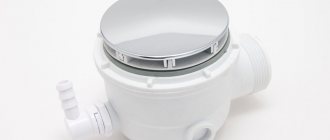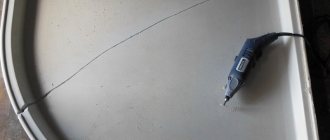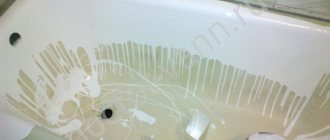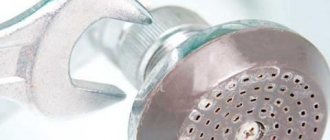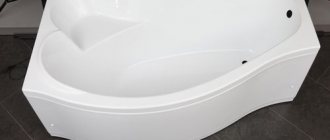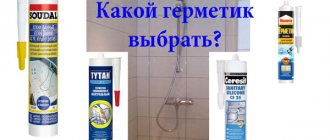The peak of popularity of acrylic bathtubs has already passed, now many users are trying to increase the life of this well-advertised plumbing fixture. Users' personal practical experience shows that manufacturers' advertising brochures are very far from reality; acrylic bathtubs have significantly more disadvantages than advantages. As a result, in all operational indicators they are significantly inferior to bathrooms made using traditional, familiar technologies.
Repair kit for acrylic bathtubs
Quite a lot of money spent by buyers does not allow them to immediately change baths that have lost their original characteristics; they try to repair them. The result of the repair depends on the qualifications of the technician and the quality of the repair kits.
If a defect appears on the bathtub, the owners try to eliminate it without completely replacing the bathtub with a new one
Important. There is no need to be under the illusion that after renovation, an acrylic bathtub will be better than a new one. At best, you will be able to restore its performance by 70–80%, keep this in mind. There are no technologies for repairing plumbing products that allow us to completely restore factory performance.
A defect on an acrylic bathtub will still be noticeable after repair, if you look closely
We will try to give objective assessments of the existing repair kits for acrylic bathtubs and give step-by-step instructions for their use. What do manufacturing companies offer for repairing acrylic bathtubs?
Types of repair kits
Types of kits for different types of damage
The reinforcing set is used to eliminate holes and deep cracks in sanitary ware. This acrylic bathtub repair kit includes glass mat, special resins, glue, acrylic bathtub repair tape, polish and sandpaper. If your bathtub is indeed made of acrylic and not ordinary fiberglass, you can get to work.
Repair tape for acrylic bathtubs is used to repair holes. With its help you need to seal the defect on the outside of the product. After this, a special acrylic reducing agent is applied to the inner surface of the plumbing fixtures. A heavily damaged surface should be reinforced with several layers of glass mat. Each subsequent layer should overlap the previous one by at least a couple of centimeters. Then the inner layer of the acrylic product must be increased using the reducing agent included in the kit.
Tip: Once curing is complete, sand the surface until it is smooth. This repair kit for acrylic bathtubs can be used not only to repair significant damage, but also to eliminate small cracks in the coating.
Chip Repair Kit
Putty, hardener and chip repair spray
This bathtub renovation kit includes:
Repair of acrylic bathtubs. Types and methods of surface restoration
- one or two cans of acrylic reducing agent;
- a set of sandpaper used for grinding and polishing an acrylic bathtub;
- polishing paste for acrylic bathtubs;
- instructions for restoring acrylic coating.
Before starting repairs, chips are very carefully drilled out along the edge so that they do not “grow” over time. For good penetration of the reducing agent into the crack, you need to widen it with a drill or knife. After this, the treated area should be degreased.
According to the instructions, prepare the composition of the required consistency and apply it to the existing cracks. The bathtub acrylic used in the kits has the ability to dissolve the edges of damage. Thanks to this, after repair the surface becomes uniform, and defects are invisible to the eye.
Please note: Special acrylic for the bathroom is suitable for any type of acrylic sanitary equipment. Having completed the polymerization process, you need to sand the coating. The included polish for acrylic bathtubs will allow you to polish your plumbing fixtures to a mirror shine.
Elimination of scratches and roughness
Scratches can be repaired with spray or liquid acrylic
A kit for repairing acrylic bathtubs with this type of damage will contain acrylic with a hardener and sandpaper ranging from 80 to 200 grit. Some kits include a special epoxy resin adhesive for acrylic bathtubs.
Stages of work:
- using a knife increases the area of damage. this will improve the quality of adhesion of the reducing agent to the surface;
- damaged areas are treated with a degreaser;
- the acrylic composition is mixed with a hardener and applied to the cracks;
- areas treated with acrylic composition should be sealed with tape;
- after the reducing agent has completely dried, the tape is removed, and the surface is ground and polished;
Tip: It often happens that minor defects, due to inaccurate preparatory work, turn into through holes. But this is not a reason to be upset; if they occur, you need to make a patch and, using glue for acrylic surfaces, glue a piece of plastic to the outside of the product. After which the hole is sealed in the manner already described.
Numerous consumer reviews indicate that the product for restoring acrylic bathtubs from reputable manufacturers allows you to use the plumbing fixtures after restoration for two to five years. Therefore, when purchasing a plumbing restoration kit, do not skimp. After all, the service life of your acrylic product depends on the quality of the materials used and the configuration.
The cost of acrylic for the bathroom included in the kit depends not only on the quality of the composition, but also on its drying time. If you are interested in which acrylic is best to purchase for the bathroom, pay attention to the drying time of the material during the work. If the manufacturer claims that acrylic dries within 6-10 hours, the quality of the material should be good.
Restoration of acrylic bathtubs. Types of damage and solutions
Polishing kit
Bathtub surface polishing kit
How to polish an acrylic bathtub? If the surface of your sanitary ware has become somewhat rough, a repair kit for polishing acrylic bathtubs will help you deal with it. Often, such a kit is suitable for eliminating yellow stains on plumbing fixtures, as well as roughness resulting from improper cleaning of surfaces.
Repair kits for polishing are the simplest, because they only contain a set of sandpaper, the polish itself and instructions for use.
Stages of work:
- the surface is moistened with water;
- begin to polish the plumbing in a circular motion, using sandpaper with a higher grit;
- after this, the surface is washed from the resulting dust and crumbs;
- then polish is applied and, using zero-grit sandpaper, a final polish is performed.
Are you looking for where to buy a repair kit for an acrylic bathtub or shower tray?
This Personal Information Privacy Policy (hereinafter referred to as the Policy) applies to all information that the Site (can receive about the user while using the site. The user’s consent to provide personal information given by him in accordance with this Policy within the framework of relations with one of the persons , included, applies to all persons. Use of the Site means the user’s unconditional consent to this Policy and the conditions for the processing of his personal information specified therein; in case of disagreement with these conditions, the user must refrain from using the Services. 1. Personal information of users that is received and processed Website 1.1. Within the framework of this Policy, “user’s personal information” means: 1.1.1. Personal information that the user provides about himself by independently filling out feedback forms, including the user’s personal data. Information required for the provision of Services (provision of services) is marked in a special way . Other information is provided by the user at his discretion. 1.1.2 Data that is automatically transmitted during their use using software installed on the user’s device, including IP address, cookie information, information about the user’s browser (or other program through which the Services are accessed), access time, address of the requested page. 1.2. This Policy applies only to the Site. The Site does not control and is not responsible for third party sites that the user can access via links available on the Site, including in search results. On such sites, other personal information may be collected or requested from the user, and other actions may be taken. 1.3. The site generally does not verify the accuracy of personal information provided by users and does not exercise control over their legal capacity. However, the Site assumes that the user provides reliable and sufficient personal information on the issues proposed in the registration form and keeps this information up to date. 2. Purposes of collecting and processing personal information of users 2.1. The site collects and stores only those personal data that are necessary for the provision and provision of services (execution of agreements and contracts with the user). 2.2. The Site may use the user’s personal information for the following purposes: 2.2.1. Identification of the party within the framework of agreements and contracts with the Site 2.2.2. Providing the user with personalized services; 2.2.3. Communication with the user, including sending notifications, requests and information regarding the use of the Services, provision of services, as well as processing requests and applications from the user; 2.2.4. Improving the quality, ease of use, development of services; 2.2.5. Targeting of advertising materials; 2.2.6. Conducting statistical and other studies based on anonymized data. 3. Conditions for processing the user’s personal information and its transfer to third parties 3.1. The site stores personal information of users in accordance with the internal regulations of specific services. 3.2. Confidentiality of the user's personal information is maintained, except in cases where the user voluntarily provides information about himself for general access to an unlimited number of persons. When using certain Services, the user agrees that a certain part of his personal information becomes publicly available. 3.3. The site has the right to transfer the user’s personal information to third parties in the following cases: 3.3.1. The user has expressed his consent to such actions; 3.3.2. The transfer is necessary as part of the user’s use of a certain Service or to provide a service to the user; 3.3.3. The transfer is provided for by Russian or other applicable legislation within the framework of the procedure established by law; 3.3.4. Such a transfer occurs as part of the sale or other transfer of a business (in whole or in part), and all obligations to comply with the terms of this Policy in relation to the personal information received by him are transferred to the acquirer; 3.3.5. In order to ensure the possibility of protecting the rights and legitimate interests of the Site or third parties in cases where the user violates the User Agreement for the Site services. 3.4. When processing personal data of users, the Site is guided by the Federal Law of the Russian Federation “On Personal Data”. 4. Change by the user of personal information 4.1. The user can at any time change (update, supplement) the personal information provided by him or part of it, as well as its confidentiality settings. 5. Measures taken to protect the personal information of users The site takes necessary and sufficient organizational and technical measures to protect the user’s personal information from unauthorized or accidental access, destruction, modification, blocking, copying, distribution, as well as from other unlawful actions of third parties with it . 6. Changes to the Privacy Policy. Applicable legislation 6.1. The site has the right to make changes to this Privacy Policy. When changes are made to the current edition, the date of the last update is indicated. The new version of the Policy comes into force from the moment it is posted, unless otherwise provided by the new version of the Policy.6.2. This Policy and the relationship between the user and the Site arising in connection with the application of the Privacy Policy are subject to the law of the Russian Federation.
Types of damage to acrylic bathtubs
The method of repairing the damage depends on how it would have been caused. Therefore, it is necessary to know the difference between them.
Chemical damage occurs due to contact between the acrylic surface and improperly selected cleaning products. In addition, acrylic may react to some components of washing powders. Most often, due to such influences, clouding of acrylic occurs , which can be easily removed by polishing it.
Mechanical damage is more serious. These include cracks and scratches of varying depths, as well as through holes. With the help of repair kits, it is possible to repair cracks up to five hundred millimeters in size and holes, the dimensions of which can reach ten centimeters in diameter.
When choosing a repair kit, you need to know how to make the bathtubs themselves.
Products made using gelcoat spraying have a thin layer of acrylic. To repair them, a special composition is used, thanks to which restoration work is carried out quite simply.
Molded bathtubs consist of a single sheet of acrylic. The thickness of the top layer of such a product must be at least four millimeters. The method for repairing bathtubs depends on the size and depth of the damage.
Recommendations before starting work
Before polishing the bathtub, you should buy from a hardware store:
- cleaning products (vinegar, car cleaner, chlorine-containing bleach);
- wax-based polishes, silver polish;
- products for chrome surfaces;
- sandpaper;
- sponges, rags, soft fabrics;
- ready repair kit.
After purchasing care products, you can begin to eliminate the shortcomings.
